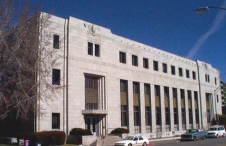Second Empire Revival Style Architecture in Nevada
The rise of France's Second Empire, established by Louis Napoleon III in 1852, became associated with an architectural style that first appeared in an extension of the Louvre at the beginning of the new emperor's reign in France. Whereas the Italianate style, from which Second Empire borrowed much of its massing and details, was part of the Picturesque movement, the Second Empire style was considered thoroughly modern. Its defining feature was the Mansard roof, generally pierced with dormers, named after seventeenth-century French architect Francois Mansart. The boxy shape of the roof allowed for an attic with usable, well-lit space, and lifted the vertical appearance of an Italianate building even more.
The Second Empire style contributes striking additions to the otherwise repetitive Italianate buildings in older Nevada historic districts. The 1885 Morrill Hall on the University of Nevada, Reno campus, as well as the 1876 Fourth Ward School and the 1863 Savage Mansion, both in Virginia City, are each excellent examples of the style. Nationally, the Second Empire style faded during the 1880s.






